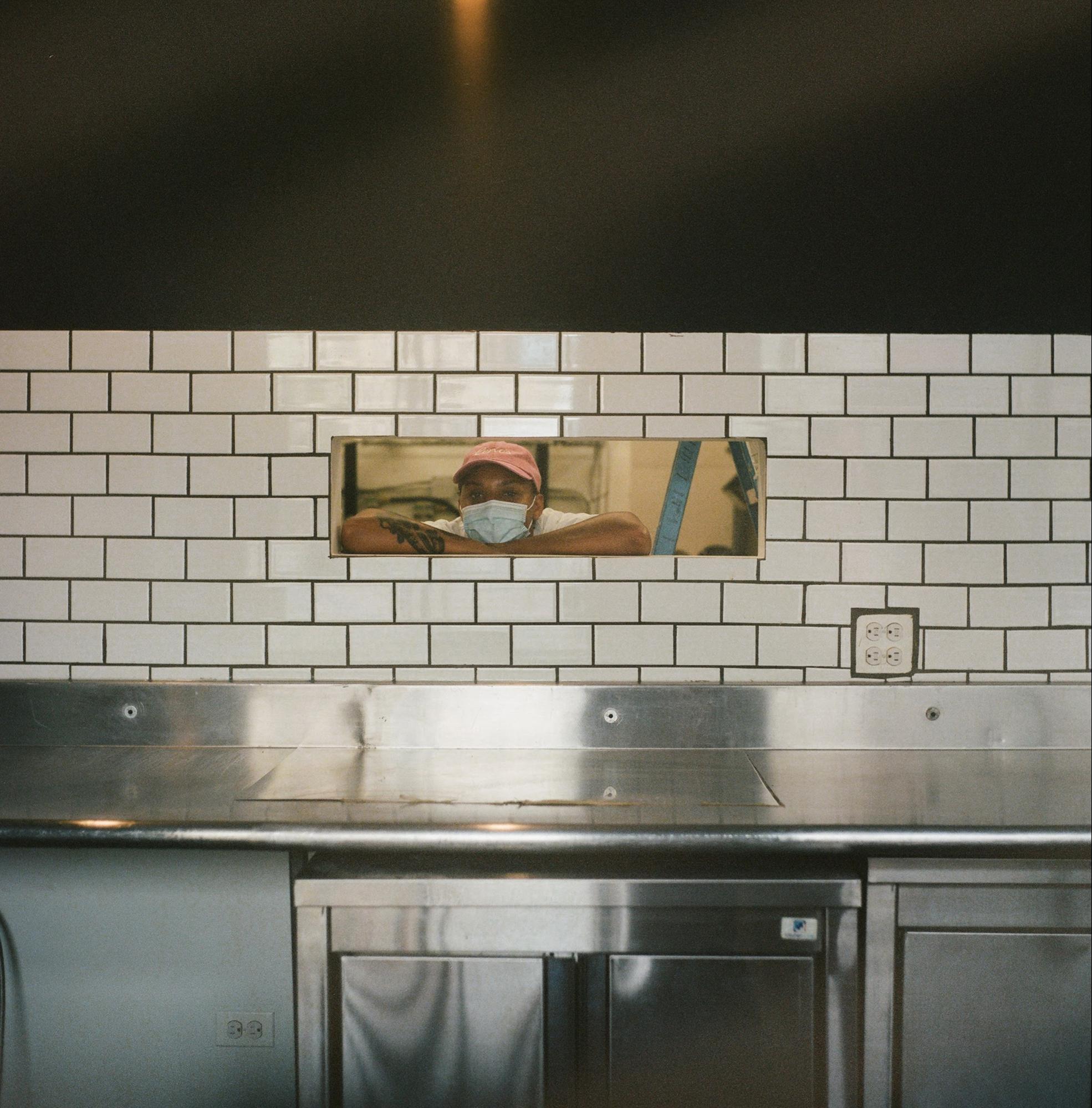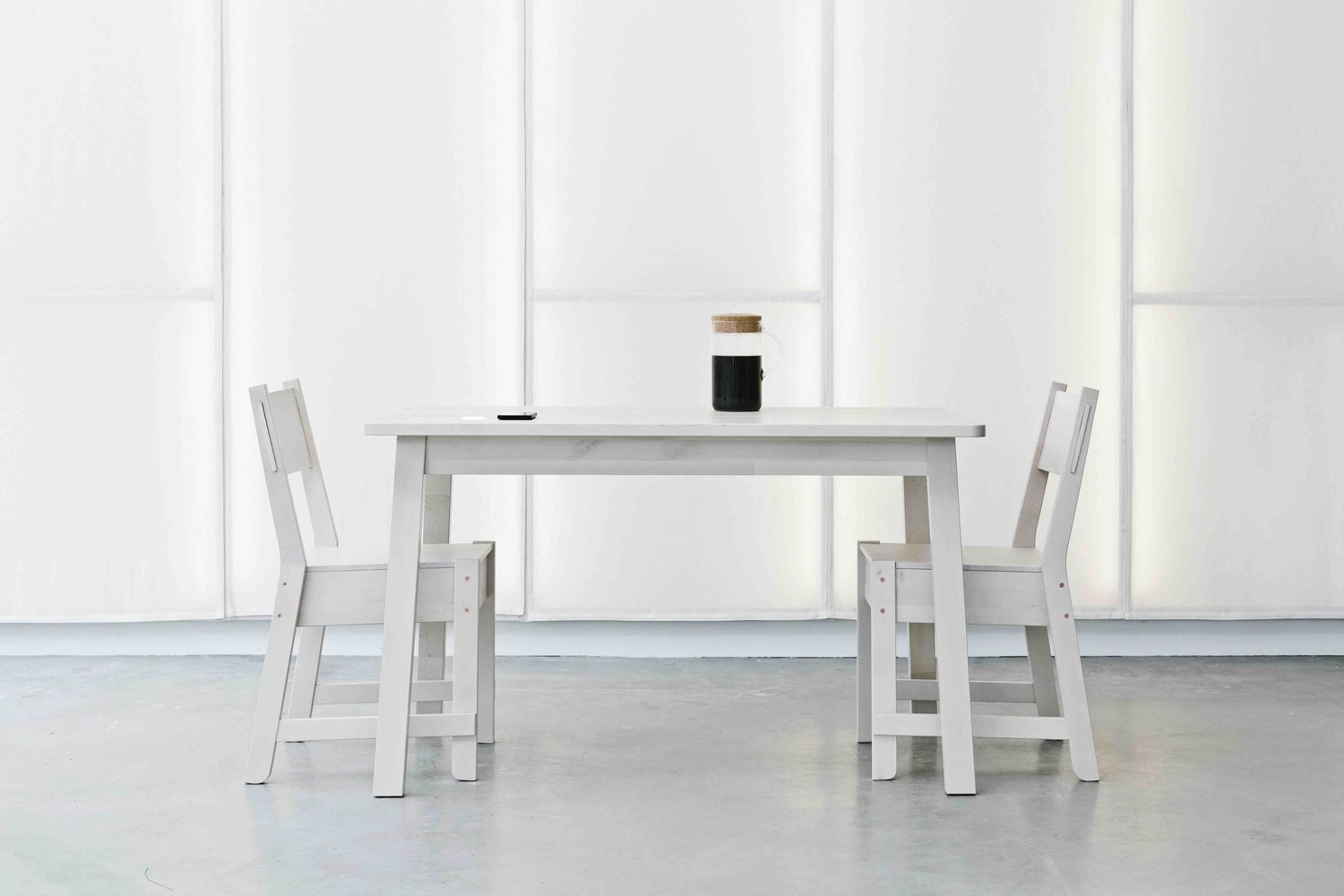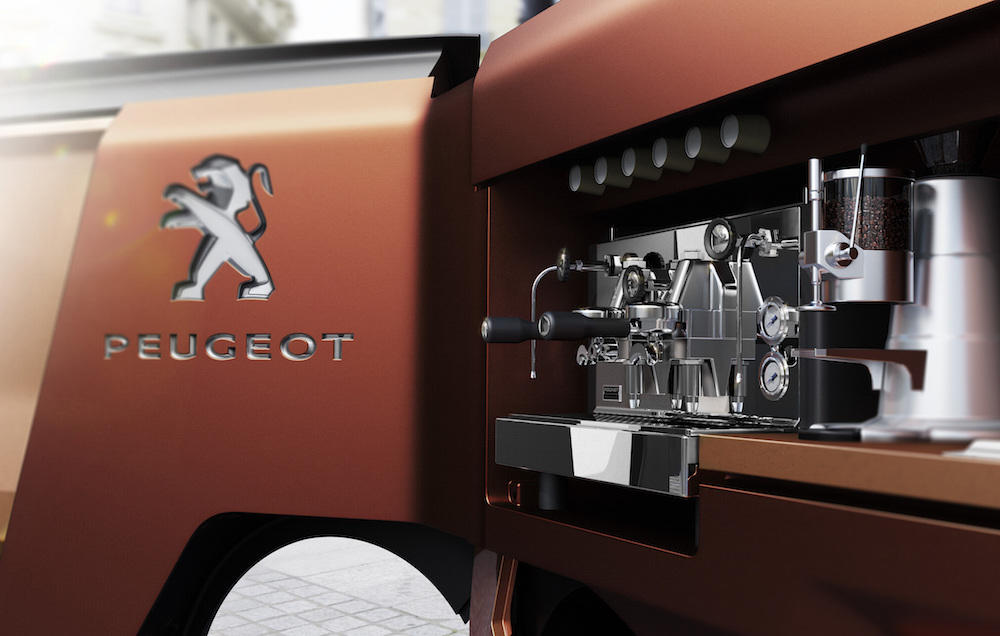In some peculiar way, eating at José Andrés’ Minibar in Washington D.C. can feel like looking at Rorschach test images or verbally unwinding on a therapist’s couch. What does this dish look like to you? How does this texture make you feel? The diners’ thoughts can meander through feelings of pleasure, antipathy, confusion and intrigue.
However, the thought experiment of this fine dining experience is not meant to be a one-sided conversation. The chefs are putting out stories through their food, but the diners’ responses to the messaging is equally important. At this intimate 12-seat restaurant, the diners at Minibar take on the role of both food investigators and research subjects in the restaurants’ three-phase NASA-inspired research process.
 Chefs Luke Feltz and Jorge Hernandez lead the R+D team at minibar
Chefs Luke Feltz and Jorge Hernandez lead the R+D team at minibar
The one-way mirror of a focus group testing facility has been smashed, so to say, and instead the experiment of stimuli and perception has been massaged into a more comfortable setting where a dialogue between chefs and diners can happen in real time and over a meal. Leading the R+D team onsite is Jorge Hernandez and Luke Feltz. Hernandez makes a nod to the R+D labs of fine dining restaurants all over the globe, but points out that the Minibar method of chef and diner interaction is unique.
At many R+D labs in restaurants, the lab experimentation is a completely separate process. Many fine dining restaurants that have an R+D team close the restaurant for a few months at a time for innovation periods. While the ethos of experimentation and innovation with ingredients and gastronomy is cited as being handed down to them from the father of modernist cuisine, Ferran Adrià and his process at elBulli, the Minibar team sees themselves as constantly iterating and exploring the food process as they interact with diners.
 Visual diagrams of elBulli’s, “Working Borard N°8: The Creative Methods,” from A Day at elBulli: An Insight into the Ideas, Methods, and Creativtity of Ferran Adrià (2008).
Visual diagrams of elBulli’s, “Working Borard N°8: The Creative Methods,” from A Day at elBulli: An Insight into the Ideas, Methods, and Creativtity of Ferran Adrià (2008).
While diners try the dishes, the kitchen team will pay attention to how many bites a diner will take of the dish, how they navigate the plate, and other affective interactions the diners have with the dish. These notes will flow back into the R+D process and serve as insights into the interaction considerations of current and future dishes and menus.
Hernandez connected R+D of Minibar dishes to the tenants of technological innovation, “it is like prototyping in some ways. We use phase development when we’re working on new dishes. There’s exit criteria for each of those phases, something we kind of stole from NASA.”
“I have a good friend that works at Johnson Space Center in Houston,” Hernandez referenced,”[who] shared with me the phase criteria for technology development at NASA. I thought, ‘this sounds exactly like the way we produce dishes.’ A little more involved, obviously, but we still adopted the language because when we would work on dishes, sometimes we felt like [the dishes] stuck in the graveyard. At NASA, they have the same thing, there’s that divot where things get stuck, and it tends to be around the later phases, we just can’t get it [where we want it to be]. We have all these dishes, and ten of them are at 90%, which one do we choose? So I thought that maybe we just need to start developing criteria for which ones get the focus.”

“For us, we’ve simplified it. NASA, I think, has seven to nine phases but we only have three phases. The first phase is that ‘demolition of ingredient into a concept’ phase, to where we know that this is a good idea, it’s got potential. But we don’t know what it is as a dish yet. It sits there in phase one until we’ve tasted something, some combination, or plated something. At that point we can see this as a dish on a menu.”
“Then it goes to phase two that is the ‘figuring out what the dish is, what it says, the kind of plate ware we need for it, the marking we need for it, how it eats,’ phase. We are waiting for that ‘wow’ moment.”
The unit of analysis over whether an experimental prototype is ready for launch onto the taste buds of diners is the truth that comes from José Andres. “José is one of the greatest people to give a dish to taste, because his facial expressions are so incredibly honest. Sometimes when you give him a dish, he’ll taste it and he won’t say anything. He’ll be thinking and thinking. Then we’ll know we’re onto something because he’s not immediately hating it. But there are times when you give him something, and he just looks at you and then he keeps eating. You walk away knowing you’ve done right. Then there’s times where you give him something and he has a different look…Before he has to say anything, you just take it away, like, okay, we’re done here, that’s not right.”
“So, phase two is where we look for that kind of emotive response. If it’s not there, then it stays in phase two until we get it there. Phase three then is the final presentation, teaching the cooks how it would go onto the menu, planning that out.”
If the diners do not like a few of the dishes, they hope for a “good batting average” with a few of the dishes or cocktails making a positive impression to balance out a negative one. They cite Adrià again, mentioning his famous 50% rule that only allowed a discussion of changing a dish if 50% or more of the guests did not like the dish.
 The R+D team at minibar had been experimenting with the sweetness of asparagus in the form of shaved ice, but just as they felt like they mastered it, the asparagus season started winding down and the results were not the same as they had been a few days earlier. Thanks to the constant dialog between diners and chefs, this was pointed out to them by a diner.
The R+D team at minibar had been experimenting with the sweetness of asparagus in the form of shaved ice, but just as they felt like they mastered it, the asparagus season started winding down and the results were not the same as they had been a few days earlier. Thanks to the constant dialog between diners and chefs, this was pointed out to them by a diner.
The ethos of creating emotive responses, positive or negative, is an important narrative device for Hernandez and Feltz through their food.
“Food is mundane. I don’t mean that as a negative thing,” Hernandez said reassuringly, “You have to eat every day. It’s a biological imperative. In that sense, food is just food. I can give you this crazy story about the R+D process, and how we developed a dish. But if you’re not in the right mindset, if you’re not hungry, if you’re not ready to receive it… then the story doesn’t mean anything. Right? At the same time, the paradox is that food can also be transcendent. One moment you are just consuming the food and then the next moment it is gone forever. Our goal in terms of our focus on storytelling through our cuisine so that we create [a powerful experience] while somebody is eating. We’re only part of that in-the-moment experience.”
This point, the in-the-moment-experience, is where hospitality comes to play as the catalyst of the diner and dish interacting. The goal at this moment is to create memories for people, tell stories, and show off the work the team has done to turn food from something mundane to something magical. With this in mind, it is crucial to stress that the R+D team exists because there is a restaurant, not that the restaurant exists because of the R+D team—fundamentally, the innovation emerges from a place of passion and desire for food experiences.

Hernandez continued, “You can choose to eat whatever you want. But what you choose to eat, how you choose to eat it, and who you choose to eat it with, is such an integral part of the human experience that that’s why we do the storytelling. It’s not a narrative for narrative’s sake, it’s not because we have to have a concept for the restaurant, and it’s not part of our marketing.”
“That’s the power of food. We create that narrative every single time we create a new dish knowing that that moment when someone eats that dish, the food is transient. However, those memories from the food can last a lifetime.”
 A meal at the minibar x Catbird Nashiville pop-up ends with a playful nod to the childhood joy of discovering a widget encased in a chocolate easter egg.
A meal at the minibar x Catbird Nashiville pop-up ends with a playful nod to the childhood joy of discovering a widget encased in a chocolate easter egg.
With the pressure of creating narratives through transient dishes, the team feels as though they are inheriting a techno-emotional legacy of gastronomy that they can build upon in their own ways. While they acknowledge the diligence of their planning, exploration, documentation and process, Hernandez points out that success and failure still boils down to getting into the kitchen and cooking for people.
Ten years ago, the concept of an R+D team may have seemed a bit fresh for the fine dining world. But as the chefs that worked under Adrià now pass on their legacy to the chefs working under them, I sense a change in tact for the culinary world in the wake of techno-emotional cuisine as it expands. The process of using technology in the kitchen has been mapped within the fine dining food industry, allowing creative energy to flow back into the consideration of interaction design and experience from a user-perspective.
“If you’re already in the kitchen and cooking,” Hernandez said, “then you’re halfway there.”















